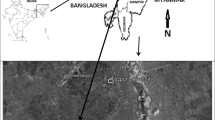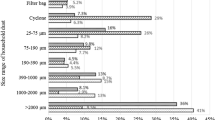Abstract
It is evident that chalk produces dust on use, i.e., particulate matter, which will alter the air quality of classrooms and can cause health hazards in teachers. The possible causes for health effects of chalk dust on teachers are still unclear. Hence, the aim of this study is to estimate the concentration of trace elements (Al, Cr, Mn, Fe, Co, Ni, Si, Pb) in chalk dust collected from classrooms by using ICP-MS. Both suspended and settled chalk dust was collected from selected classrooms. Suspended chalk dust was collected with PM2.5 filter paper using fine dust sampler, and settled chalk dust was collected by placing petriplates at a distance of 3 m from the board for a duration period of 30 min. Scanning electron microscopy images of chalk dust were taken up. Potential health risk analysis was also assessed. Results showed that Al, Fe, and Mn are in higher concentration (>1000 μg kg−1) in both settled and suspended chalk dust. Cr, Mn, Fe, Co, and Ni were beyond the minimal risk levels in both settled and suspended chalk dust. There are no minimal risk levels for the elements Al, Si, and Pb. The concentration of trace elements in suspended chalk dust was higher than that in settled chalk dust. The SEM images of PM2.5 filter papers (suspended chalk dust) showed that all pores of the sampled filter papers are clogged with chalk dust. The few SEM images of the settled chalk dust showed fibrous shape which is associated with good-quality chalk whereas others showed circular and more aggregated nature of chalk dust from low-quality chalk from which the dust production will be very high. As observed from the result that the trace elements concentration was high in the suspended chalk dust, the fact can be correlated with the SEM images which have shown high density of absorbed chalk dust. With reference to human health risk, dermal exposure was the main route of exposure followed by inhalation and ingestion. Al (aluminum), Fe (iron), Si (silicon), and Mn (manganese) are the major contributors for the non-carcinogenic effects. For all the elements, the carcinogenic effect calculated (LADD) is within the global acceptable limit (10−6–10−4).



Similar content being viewed by others

References
Thareja P, Jayjee GK, Dawan I, Single P (2011) Comparative analysis of PowerPoint and black board teaching methodologies. Curr Trends Ininformationtechnologies 1:8–15
Nikam KD, Hirkani MA (2013) Effect of chalk dust on peak exploratory flow rate in school teachers. Int J Med Health Sci 2:407–409
Lin C-c, Lee M-k, Huang H-L (2015) Effects of chalk use on dust exposure and classroom air quality. Aerosol Air Qual Res 15:2596–2608
Caroline Dyer (1996) The improvement of primary school quality in India: success and failures of Operation black board. Edinburg papers in south asian studies 4.
Nasir S (1996) Minerology, petrography and manufacturing of good quality chalk. Qatar Univ Sci J:325–331
Manish Takker, Premal Shukla, Dinesh Oshan (2016) Surface and colloidal properties of chalk: a novel approach using surfactants to convert normal chalks into dustless chalks 1–9. doi:10.1016/j.colsurfa.2015.01.054
Majumdar D, William SP (2009) Chalk dust fall during classroom teaching: particle size distribution and morphological characteristics. Environ Monit Assess 148:343–351
Alves C, Nunes T, Silva J, Duarte M (2013) Comfort parameters and particulate matter (pm10 and pm2.5) in school classrooms and outdoor air. Aerosol Air Qual Res 13:1521–1535
Alves CA, Urban RC, Pegas PN, Nunes T (2014) Indoor/outdoor relationships between pm10 and associated organic compounds in a primary school. Aerosol Air Qual Res 14:86–98
Raith L, Jaeger K (1986) The nickel content of chalk—cause of contact dermatitis? Contact Dermatitis 14:61
Corazza M, Zauli S, Pagnoni A, Virgili A (2011) Allergic contact dermatitis caused by metals in black board chalk: a case report. Acta Derm Venereol 92:436–437
Mainka A, Zajuska-Zubek E, Kaczmerk K (2015) PM2.5 in urban and rural nursery schools in upper Silesia Poland. Trace Elements Anal 12:7990–8008. doi:10.3390/ijerph120707990
Mafesty VK, Deideiu CS, Seidel CR, Nerriera E, Chee CC (2006) Do teachers have more health problems? Results from a French cross sectional survey. Bio Med Central 6:1–13
Zhang Y, Yang Z, Feng Y, Li R, Zhang Q, Geng H, Dong C (2015) Effects of coarse chalk dust particles (2.5-10 μm) on respiratory burst and oxidative stress in alveolar macrophages. Environ Sci Pollut Res Int 08:2450–2457. doi:10.1007/s11356-015-4437-3
Maruthi YA, das Lakshmana N, Ramprasad S, SS R, Sudarshan S (2015) Trace elements analysis of school chalk using energy dispersive X-ray florescence(ED-XRF). AIP Conference Proc 1675:030088-1–030088-3. doi:10.1063/1.4929304
Fromme H, Twardella D, Dietrich S, Heitmann D, Schierl R, Liebl B, Ruden H (2007) Particulate matter in the indoor air of classrooms—exploratory results from Munich and surrounding area. Atmos Environ 41:854–886
Sharma M, Maloo S (2005) Assessment of ambient air PM10 and PM 2.5 and characterization of PM 10 in the city of Kanpur, India. Atmos Environ 39:6015–6026
Hseu Z–Y (2004) Evaluating heavy metal contents in nine composts using four digestion methods. Bioresour Technol 95:53–59
Chudzinska M, Debska A, Baralkiewicz D (2012) Method validation for determination of 13 elements in honey samples by ICPMS. Accred Qual Assur 17:65–73. doi:10.1007/s00769-011-0812-z
Fayez Hassan (2011) Investigation of lecturers chalk by X-ray florescence and fast neutron activation techniques. Proceedings of the 8th Conference on Nuclear and Particle Physics 207–212.
USEPA (United States Environmental Protection Agency) (1989) Human Health Evaluation Manual. EPA/540/1e89/002. In: Risk Assessment Guidance for Superfund, vol. l. Office of Solid Waste and Emergency Response.
USEPA (United States Environmental Protection Agency), (1996) Soil Screening Guidance: Technical Background Document. EPA/540/R-95/128. Office of Solid Waste andEmergency Response.
Zhu Z, Sun G, Bi X, Li Z, Yu G (2013) Identification of trace metal pollution in urban dust from kindergartens using magnetic, geochemical and lead isotopic analyses. Atmos Environ 77:9–15
Zheng N, Liu J, Wang Q, Liang Z (2010) Health risk assessment of heavy metal exposure to street dust in the zinc smelting district, northeast of China. SciTotal Environ 408:726–733
Shi G, Chen Z, Bi C, Wang L, Teng J, Li Y, Xu S (2011) A comparative study of health risk of potentially toxic metals in urban and suburban road dust in the most populated city of China. Atmos Environ 45:764–771
Hu X, Zhang Y, Ding Z, Wang T, Lian H, Sun Y, Wu J (2012) Bioaccessibility and health risk of arsenic and heavy metals (Cd Co, Cr, Cu, Ni, Pb, Zn and Mn) in TSP and PM2.5 in Nanjing. China Atmos Environ 57:146–152
Li H, Qian X, Hu W, Wang Y, Gao H (2013) Chemical specification and human health risk of trace metals in urban street dusts from a metropolitan city,Nanjing, SE China. Sci Total Environ 456–457:212–221
Sun G, Li Z, Bi X, Chen Y, Lu S, Yuan X (2013) Distribution, sources and health risk assessment of mercury in kindergarten dust. Atmos Environ 73:169–176
USEPA (United States Environmental Protection Agency) (2001) Supplemental Guidance for Developing Soil Screening Levels for Superfund Sites. OSWER 9355.4e24. Office of Solid Waste and Emergency Response.
Van den Berg R (1995) Human exposure to soil contamination: a qualitative and quantitative analysis towards proposals for human toxicological intervention values. RIVM Report no. 725201011. National Institute of Public Health and Environmental Protection (RIVM), Bilthoven, The Netherlands.
Khairy MA, Barakat AO, Mostafa AR, Wade TL (2010) Multielement determination by flame atomic absorption of road dust samples in Detla Region, Egypt. Microchem J 97:234–242
Fromme H, Diemer J, Dietrich S, Cyrys J, Heinrich J, Lang W, Kiranoglu M, Twardella D (2008) Chemical and morphological properties of particulate matter (PM10.PM2.5) in school classrooms and outdoor air. Atmos Environ 42:597–660
Olujimi O, Steiner O, Goessler W (2015) Pollution indexing and health risk assessments of trace elements in indoor dusts from classrooms, living rooms and offices in Ogun State, Nigeria. J Afr Earth Sci 101:396–404
Tran DT, Alleman LY, Coddeville P, Galloo J-C (2012) Elemental characterization and source identification of size resolved atmospheric particles in French classrooms. Atmos Environ 54:250–259
Risk Assessment Information System (RAIS), (2004) United States Department of Energy.
World Health Organization (WHO) (1993) Guidelines for drinking water quality. Second Edition. Recommendations.Volume.I. Geneva.
Vaidya P, Kashyap S, Sharma A, Gupta D, Mohapatra PR (2007) Respiratory symptoms and pulmonary function tests in school teachers of Shimla. Lung India 24:6–10
Mulware SJ (2013) Trace elements and carcinogenicity: a subject in review, 3. Biotech 3:85–96
Liang Sun YY, Huang T, An P, Yu D, Yu Z, Li H, Sheng H, Cai L, Xue J, Jing M, Li Y, Lin X, Wang F ((2012) Associations between ionomic profile and metabolic abnormalities in human population. PLoS One 7:1–10
ATSDR (Agency for Toxic Substances and Disease Registry) (2016) http://www.atsdr.cdc.gov/mrls/mrllist.asp.
Acknowledgments
The authors are grateful to the UGC (University Grants Commision) New Delhi for providing financial assistance to carry out this work. The authors are also grateful to the Centre for studies on Bay of Bengal Laboratory, Andhra University, for permitting us to carry out the ICP-MS analysis in their laboratory. The authors are also grateful to the GITAM University for providing necessary lab facilities.
Authors’ Contributions
All the authors read and approved the final manuscript.
Author information
Authors and Affiliations
Corresponding author
Ethics declarations
Competing Interests
The authors declare that they have no competing interest.
Rights and permissions
About this article
Cite this article
Maruthi, Y.A., Ramprasad, S. & Lakshmana Das, N. Trace Elemental Characterization of Chalk Dust and Their Associated Health Risk Assessment. Biol Trace Elem Res 175, 466–474 (2017). https://doi.org/10.1007/s12011-016-0769-1
Received:
Accepted:
Published:
Issue Date:
DOI: https://doi.org/10.1007/s12011-016-0769-1



